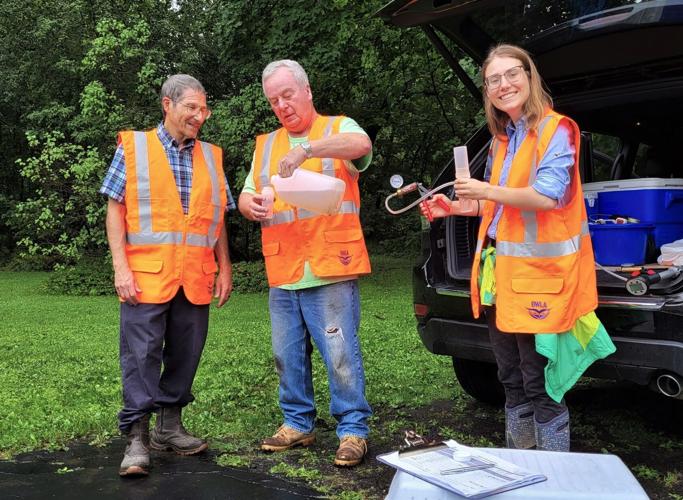https://auburnpub.com/lifestyles/aluisio-owla-volunteers-lead-projects-for-owasco-lakes-protection/article_9078d218-771b-543f-b992-fd4910aa2a2a.html#tracking-source=home-top-story
The Owasco Watershed Lake Association is a local, volunteer-based nonprofit that does an incredible job contributing to the protection of Owasco Lake. Deemed the 2022 Nonprofit of the Year by the Cayuga County Chamber of Commerce, OWLA does great work in many areas; its passionate network of volunteers acquires and utilizes resources to support a wide array of projects. The lake association’s diverse project portfolio extends well beyond what can be covered in one short article. However, OWLA’s website, owla.org, provides a comprehensive view of project information, as well as an opportunity to reach out for those who want to get involved.
One of OWLA’s many noteworthy projects is the Owasco Hemlock Wooly Adelgid Suppression Program. HWA is an invasive insect that is actively killing local hemlock trees. Hemlocks are vital to the watershed, as their roots maintain the integrity of streambanks and steep ravines. Hemlock tree canopies also shade streams to keep water cool for fish and other species. The landscape would be significantly altered if they were to die out. OWLA’s HWA Suppression Program began in 2020 and will continue for several years. According to program coordinator Dana Hall, “To date, more than 9,200 hemlocks considered watershed-critical have been treated with insecticide, and now that hunting season is done, we are starting to go back out with private property owners’ permission to look for any additional trees.” The long-term goal is for certain insect species native to the western U.S., which are predators to HWA, to be safely introduced by Cornell. This would hopefully create a food web control for the adelgids and strike a positive balance.
OWLA contracts with local certified pesticide applicators, who apply the pesticide imidacloprid to the lower trunk of the tree, sprayed onto the bark. For more critically infested trees, a mixture of imidacloprid and dinotefuran (which acts more rapidly) is applied. However, these are both expensive applications — sometimes up to $25 per tree, and even more costly when the mixture is required. With this in mind, OWLA targets hemlocks that are critical to maintaining clean water: those lining the upper edges and down the sides of ravines, gullies, gorges, etc. This means those hemlocks deemed non-critical will go untreated without landowner intervention. Landowners that are interested in more information and resources to tackle HWA on their own property can reach out to Caroline Marschner (cam369@cornell.edu) and Ryan Staychock (rms462@cornell.edu) with Cornell Cooperative Extension, or Matthew Gallo (gallo@hws.edu) with the Finger Lakes Partnership for Regional Invasive Species Management.
Another noteworthy project of OWLA’s is to support watershed-wide ditch stabilization. Their funding match program covers the cost of stabilization for municipalities in full. Formerly led by the late Rick Nelson, the mantle has been taken up by OWLA members Dan Kuhn and Herb Walser, who are working to spread the word to municipalities to help facilitate the program.
In the spring and summer months, highway crews scrape out ditches that have filled up with sediment, which reduces their water-carrying capacity. This leaves the soil bare and at risk to be carried to surface waters. Ditches are unregulated water conveyance systems that often connect directly to streams or lakes. Ensuring that ditches are properly vegetated after being scraped out is the simplest method to minimize sediment and nutrients being transported to the lake.
The most common solution, then, is to hydroseed the ditch: to spray a wet mixture of seed, mulch and other additives on bare soils to expedite the growth of vegetation. The Cayuga County Soil and Water Conservation District owns a hydroseeder, and will cover the cost of hydroseeding ditches at 75%. With this program, towns and villages that are commonly expected to contribute the remaining 25% don’t need to cover that cost; OWLA can cover that remaining 25%.
In addition to these two efforts, OWLA members are involved in a variety of other projects, including but not limited to: organizing a network of trained reporters for the Department of Environmental Conservation’s harmful algal bloom surveillance in Owasco Lake; stream sampling to support local watershed planning and research, like the recent 9 Element Plan; the creation and maintenance of a rain garden at Emerson Park; and work to educate the local population to be more “watershed aware,” as well as providing educational initiatives at schools and libraries.
OWLA hosts local lake scientists and other presenters during the annual Bob Brower Scientific Symposium “In Plain English,” for anyone interested in attending. In 2023, the symposium will be held from 9 a.m. to noon Saturday, March 11, at Auburn Public Theater. There is also a hybrid option being offered for those who wish to attend virtually. This year’s topic is “Effects of Climate Change on Owasco Lake.”

Recent Comments